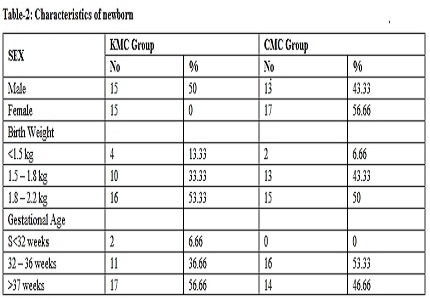Effect of kangaroo mother care in the management of low birth weight babies one year randomized controlled trial at NRI hospital
Abstract
Introduction: Hypothermia and infections are frequently factors for poor outcome of premature /LBW babies.
Methods: A one year randomized controlled trial was conducted among 60 neonates born and admitted in NICU, department of paediatrics, NRI medical college, Guntur. Mothers with LBW infants were enrolled after taking informed consent. Babies were randomised into KMC group and CMC group with 30 babies in each group. In both groups, physiological stability, growth, promotion of breast feeding, bonding and confidence of mothers in taking care of their LBW babies were assessed. Both groups were followed till they reached 2.5 kg on scheduled visits.
Results: In the present study, it was observed that all babies of KMC maintained temperature in normal range. 36.5 to 37.5 compared to 86.6% of control babies. The mean weight gain (15.73 gm in KMC versus 11.63 gm in CMC, P< 0.0001 ) and mean head circumference at 2.5 kg, ( 34.440.5+4 cm in KMC VS 33.220+54 cm 33.221.0+5 cm in CMC), p< 0.0001 were significantly higher in KMC group. There was no significant difference in mean length between both the groups. The confidence level of mothers in caring for their LBW infants was significantly higher in KMC group p< 0.0001.
Conclusion: KMC is a cost effective, safe, most acceptable method of caring for LBW babies.
Downloads
References
2. World Health Organization. Essential newborn care. Report of a Technical Working Group, Trieste, 25-29 April 1994. Geneva: Maternal and Newborn Health. Safe Motherhood (WHO/FRH/MSM/96.13). 1996. [PubMed]
3. Ashworth A. Effects of intrauterine growth retardation on mortality and morbidity in infants and young children. Eur J Clin Nutr. 1998 Jan;52 Suppl 1:S34-41; discussion S41-2. [PubMed]
4. Murray CJ, Lopez AD. The Global Burden of Disease: a comprehensive assessment of mortality and disability from diseases, injuries and risk factors in 1990 and projected to 2020. Cambridge, MA, Harvard School of Public Health, (Global Burden of Disease and Injury Series, vol. I), 1996.
5. Mew AM, Holditch-Davis D, Belyea M, Miles MS, Fishel A. Correlates of depressive symptoms in mothers of preterm infants. Neonatal Netw. 2003 Sep-Oct;22(5):51-60. [PubMed]
6. Rey ES, Martinez HG. Manejo racional del niño prematuro. Universidad Nacional, Curso de Medicina Fetal, Bogotá, Universidad Nacional. 1983. [PubMed]
7. World Health Organisation. Kangaroo Mother Care: A practical guide. Geneva: Department of reproductive health and research, WHO; 2003.
8. Ramanathan KP, Paul VK, Deorari AK, Taneja U, George G. Kangaroo Mother Care in very low birth weight infants. The Indian Journal of Pediatrics. 2001 Nov 1;68(11):1019-23. [PubMed]
9. Gupta M, Jora R, Bhatia R. Kangaroo mother care (KMC) in LBW infants—a western Rajasthan experience. The Indian Journal of Pediatrics. 2007 Aug 1;74(8):747-9. [PubMed]
10.Suman RP, Udani R, Nanavati R. Kangaroo mother care for low birth weight infants: a randomized controlled trial. Indian Pediatr. 2008 Jan;45(1):17-23.
11. Charpak N, Ruiz-Peláez JG, Charpak Y. A randomized, controlled trial of kangaroo mother care: results of follow-up at 1 year of corrected age. Pediatrics. 2001 Nov 1;108(5):1072-9. [PubMed]
12. Kadam S, Binoy S, Kanbur W, Mondkar JA, Fernandez A. Feasibility of kangaroo mother care in Mumbai. The Indian Journal of Pediatrics. 2005 Jan 1;72(1):35-8. [PubMed]
13. Ibe OE, Austin T, Sullivan K, Fabanwo O, Disu E, Costello AD. A comparison of kangaroo mother care and conventional incubator care for thermal regulation of infants< 2000 g in Nigeria using continuous ambulatory temperature monitoring. Annals of Tropical Paediatrics: International Child Health. 2013 Jul 18.
14. Bergman NJ, Jurisco LA, Kangaroo mother care and early skin to skin contact as determinants of breast feeding success, Moy Bay maternity hospital, Cape town, South Africa. Tropical Doctor 1994; 24:57-60.
15. Schmidt E, Wittreich G. Care of the abnormal newborn: a random controlled trial study of the “kangaroo method” of care of low birth weight newborns. InConsensus Conference on Appropriate Technology Following Birth, Trieste, 7-11 October 1986 1986 Oct.
16. Cattaneo A, Davanzo R, Worku B, Surjono A, Echeverria M, Bedri A, Haksari E, Osorno L, Gudetta B, Setyowireni D, Quintero S. Kangaroo mother care for low birthweight infants: a randomized controlled trial in different settings. Acta Paediatrica. 1998 Sep 1;87(9):976-85.
17. Christensson K, Siles C, Moreno L, Belaustequi A, De La Fuente P, Lagercrantz H, Puyol P, Winberg J. Temperature, metabolic adaptation and crying in healthy full‐term newborns cared for skin‐to‐skin or in a cot. Acta paediatrica. 1992 Jun 1;81(6‐7):488-93.
18. Tessier R, Cristo M, Velez S, Girón M, de Calume ZF, Ruiz-Paláez JG, Charpak Y, Charpak N. Kangaroo mother care and the bonding hypothesis. Pediatrics. 1998 Aug 1;102(2):e17. [PubMed]

Copyright (c) 2016 Author (s). Published by Siddharth Health Research and Social Welfare Society

This work is licensed under a Creative Commons Attribution 4.0 International License.


 OAI - Open Archives Initiative
OAI - Open Archives Initiative


